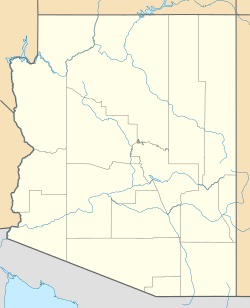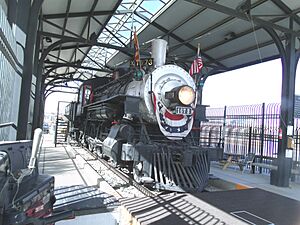Southern Pacific 1673 facts for kids
Quick facts for kids Southern Pacific 1673 |
||
| [[Image:Locomotive 1673 (Tucson, Arizona) 2.JPG | alt=Steam locomotive in roofed outdoor enclosure]] | |
| Southern Pacific 1673 on display at Southern Arizona Transportation Museum | ||
| Power type | Steam | |
|---|---|---|
| Builder | Schenectady Locomotive Works | |
| Serial number | 5683 | |
| Build date | November 1900 | |
| Total production | 153 | |
| Configuration | 2-6-0 | |
| Gauge | 4 ft 8 1⁄2 in (1,435 mm) | |
| Driver diameter | 63 in (160 cm) | |
| Weight on drivers | 134,600 lb (61 t) | |
| Locomotive weight | 157,900 lb (72 t) | |
| Fuel type | Original: Coal 1906: Oil |
|
| Boiler pressure | 190 psi (1.3 MPa) | |
| Heating surface: Tubes and flues | 1,350 sq ft (125 m2) | |
| Heating surface: Firebox | 156 sq ft (14 m2) | |
| Heating surface: Total | 1,506 sq ft (140 m2) | |
| Superheater area | 269 sq ft (25 m2) | |
| Cylinders | 2 | |
| Cylinder size | 20 in × 28 in (508 mm × 711 mm) | |
| Valve gear | Stephenson | |
| Tractive effort | 28,710 lbf (128 kN) | |
| Last run | 1965 | |
| Retired | 1955 | |
| Disposition | Static Display | |
|
Southern Pacific Railroad Locomotive No. 1673
|
||
| Location | Southern Pacific Depot, Tucson, Arizona | |
| Area | less than one acre | |
| Built | 1900 | |
| Architect | Schenectady Locomotive Works | |
| Architectural style | Mogul 2-6-0 | |
| NRHP reference No. | 91001918 | |
| Added to NRHP | January 9, 1992 | |
Southern Pacific Railroad 1673 is a special kind of steam locomotive known as a Mogul. This means it has a 2-6-0 wheel arrangement. It was built in 1900 by the Schenectady Locomotive Works. This powerful engine arrived in Tucson, Arizona in late 1900 or early 1901. It spent most of its working life in southern Arizona, pulling heavy freight trains.
Contents
A Working Life: Pulling Freight Trains
From 1901 to the 1940s, Locomotive 1673 traveled over a million miles. It mainly worked out of Tucson, Arizona. The locomotive pulled freight trains on many short routes in southern Arizona. Sometimes, it traveled as far south as Nogales, Arizona. It also went west to Yuma. Other places it visited included Benson, Patagonia, and Tombstone.
Changes and Upgrades Over Time
Locomotive 1673 had several big updates during its working years. In 1906, it was changed from using coal to burning oil for fuel. This made it more efficient.
By 1922, the locomotive went to the shops in Sacramento, California. There, it got a major rebuild. Workers added a special part called a superheater to its smokebox. This upgrade helped the engine create more power.
From Freight to Film Star
By the early 1950s, Locomotive 1673 was mostly used for moving cars around the train yard. This job is called "switching." It didn't get used much as newer diesel locomotives took over.
In 1955, the locomotive had a brief starring role. It appeared in the movie Oklahoma. For the film, it was given a special look from the early 1900s. This included a diamond-shaped smokestack.
After the movie, the locomotive was used for a photo shoot in Sahuarita, Arizona. Two days later, it was the star of Southern Pacific's 75th anniversary in Tucson. It pulled a special train all day long. After this, the railroad gave the locomotive to the city of Tucson.
A New Home: On Display for Everyone
Soon after being donated, the engine was put on display. It was placed in front of the Pioneers Historical Society. At this time, the locomotive was in great shape and could still run.
In 1962, the locomotive had to move. Construction at the Historical Society meant there was no room for it. So, it was moved to Himmel Park in Tucson.
Challenges at Himmel Park
At Himmel Park, the engine sat outside for many years. It was exposed to the weather and slowly started to wear down. Sadly, some parts were stolen or damaged. These included its builder's plates and gauges.
People tried to move or fix the locomotive many times. But it was hard to make progress. In 1965, there was an attempt to get it running. The locomotive was briefly steamed up. It even moved a short distance on its display track. However, it accidentally ran off the track. Volunteers quickly fixed it within a year.
Efforts to Restore and Preserve
In 1984, some Tucson business people spent about $20,000. They checked the locomotive's boiler to see if it could run again. They found it was possible to restore it. But the cost to fix the boiler was too high. So, the project was stopped.
By the early 1990s, the engine was in poor condition. Many thought it might be scrapped. A group of people formed the "1673 Task Force." Their goal was to save the engine. In 1992, the locomotive was added to the National Register of Historic Places. This means it is an important historical item.
By 1994, the engine was taken apart. It was cleaned, fixed, and put back together. Now, it looks much like it did in 1955. This was when it was first given to the people of Tucson.
Back to the Historic Depot
In December 2000, the engine moved again. It left Himmel Park and went to the Southern Pacific Depot in downtown Tucson. Over the next two years, a special shelter and fence were built around it. This protected the locomotive.
The work finished in September 2002. A special ceremony was held to celebrate. By March 20, 2005, the locomotive was open for public viewing. This happened after the depot itself was also restored.
Ongoing Care: Keeping History Alive
As of January 2011, the Southern Arizona Transportation Museum began new efforts. They wanted to further repair and preserve Locomotive 1673. They started by changing its paint. The goal was to make it look exactly as it did in the early to mid-1950s.
This work includes painting parts like the injectors and check valves red. This was how Southern Pacific locomotives looked. Other parts, like the smokebox and wheels, received new coats of black, white, and silver paint.
By summer 2011, more work began. Parts that were removed during the 1992-1994 restoration were cleaned. They were then put back onto the locomotive. Workers are also getting the cab ready for new wood paneling. They are also looking for or making new parts. These replace pieces that were lost, stolen, or too damaged to fix.




